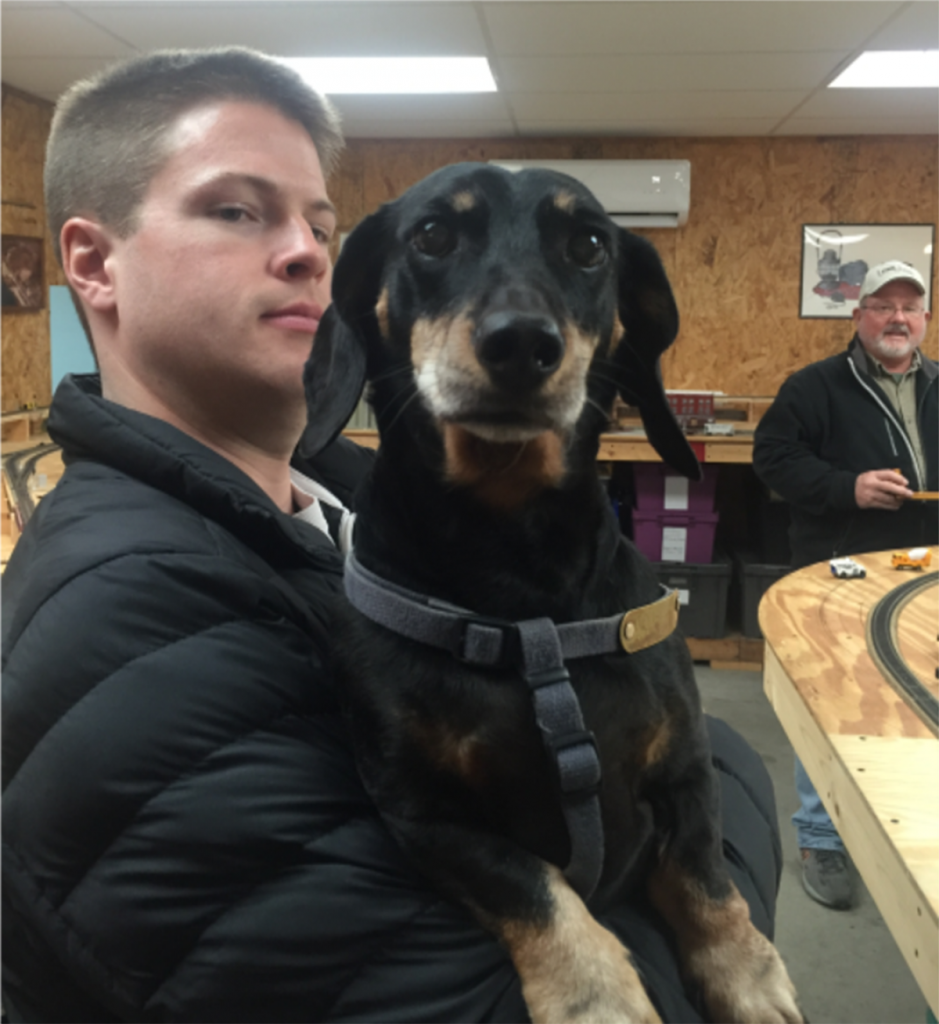
Matt Gentry and friend Max are at Holy Train Night at Keith Kittinger’s HO layout, Madisonville, Ky.


Matt Gentry and friend Max are at Holy Train Night at Keith Kittinger’s HO layout, Madisonville, Ky.
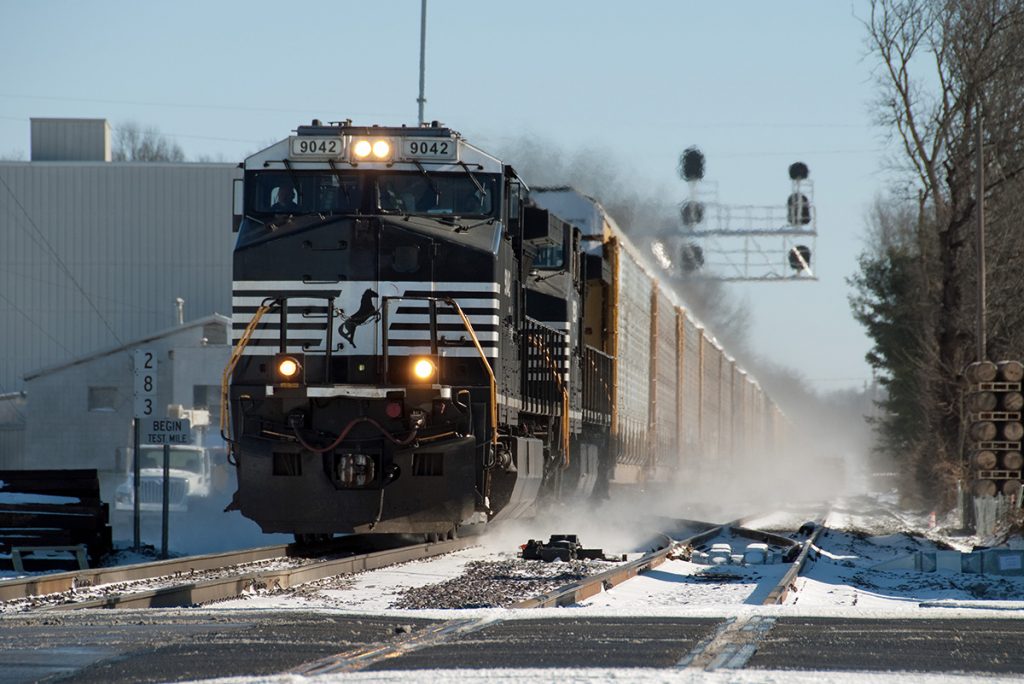
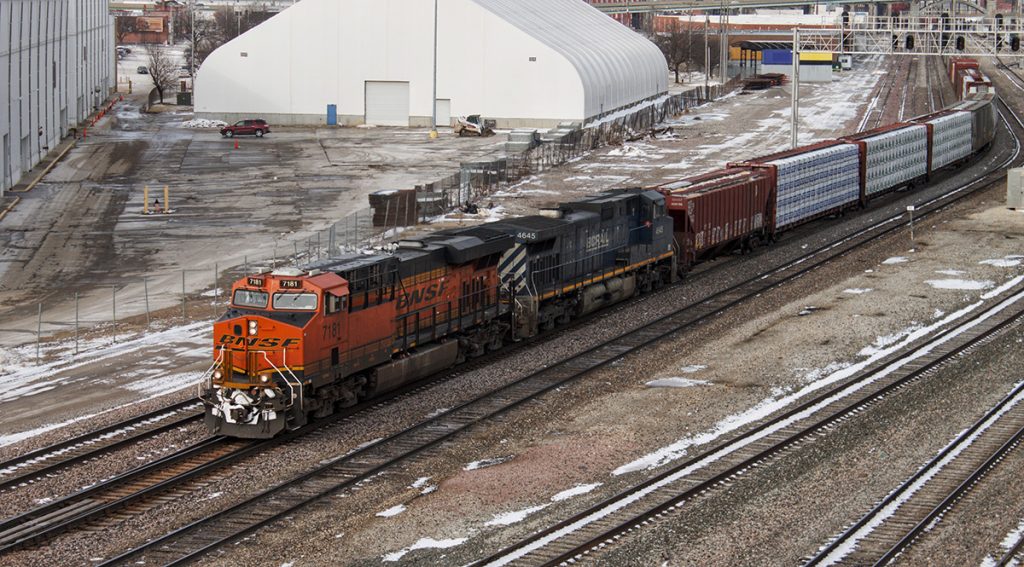
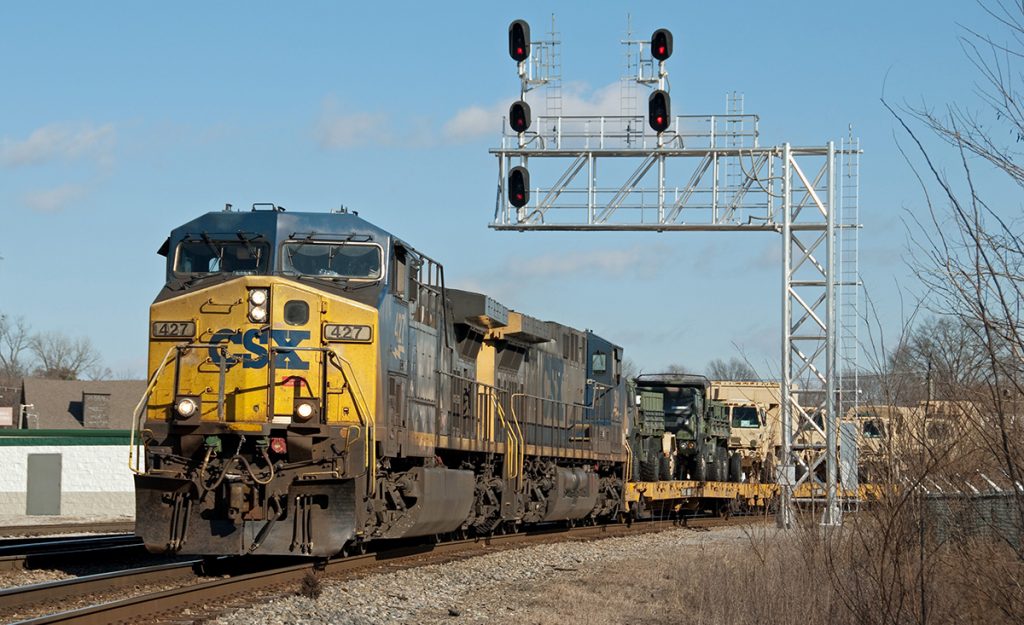
Before we got used to the jumbo covered hopper cars so prevalent now, grain was shipped in a common 40’ boxcar. In the early days grain was shipped by the sack. Bulk grain shipment by rail required the use of a temporary grain door secured inside the doorway. In the picture to the left, the wooden door has been removed and the men are manually shoving product out the door.
In the other picture, a loaded boxcar is being mechanically tilted and tipped to completely off-loading the product. The car was secured firmly, then raised to about a 45-degree slope, and tipped side-to-side. The car is lowered and the process is repeated as the other end is lifted. This time the car will be tilted before it is raised in hopes of the product not refilling the far end of the car. The whole process was fairly swift, as I recall watching at the Port-of-Tacoma back in the 50s, probably five minutes total. With all those fancy dressers observing behind the protective glass, , and there are no other cars lined up, this appears to be a demo.
Back at the grain elevator before loading, the grain door was secured and heavy paper lining was applied generously to all surfaces. When loading is complete, the regular sliding steel door could scoot past the temporary grain door and be secured. More than one loaded grain car arrived nearly empty, days later after bumping along over the clickety-clack. Such happenstance kept railroad claims adjusters busy. Even one tiny break in the paper, in the wrong place, with tons of pressure, for a week or more, could wreak havoc. Pigeons and others loved it.
Grain doors only went a little more than halfway up the boxcar door opening, varying some due to the weight and density of the product. Corn, soy beans, and rice received the same treatment.
Reportedly, the very last grain-filled boxcars left the elevators in western Oklahoma in the Spring of 1978. The Missouri-Kansas-Texas Railroad, better known as the “KATY” did the honors. Why was it called KATY, you ask? Because the KATY’s New York Stock Exchange ticker-tape symbol was “KT”.
Credits: photos from the Oregon Historical Society, as seen in the Union Pacific Railroad Historical Society’s Streamliner Fall 2011 issue.
Submitted by Gary Ostlund

Greetings fellow NRHS Western Kentucky Chapter members. And welcome to January, 2019. My oh my what are year 2018 was. Looking back we had the Christmas show at the mall, breakfast with Santa, an excellent Christmas dinner at the Miller residence, a picnic and rail fan day at Crofton, a railfan day in Hopkinsville, a meeting in Hopkinsville, a track side day in Morton’s Gap not to mention numerous meetings, impromptu get-togethers and programs a plenty. I feel 2019 will be even better.
As you are aware, we did not have a business meeting in December however, we did have the aforementioned dinner at the Miller residence, a very successful breakfast with Santa and a successful Christmas show at the mall. Bill Farrell will have a report on the earnings from those events. Not to mention the raffle which netted us additional monies as the winner did not take the train set.
We did however have a meeting in November. Which also brought about elections of officers for 2019. There were no changes in officers as all were voted in by a single vote of acclamation. To which I say thank you. Hopefully I can serve as President as need be.
2018 also brought on a few new members. It is nice to think that we can continue to grow in this age of electronics and instant gratification. As for growing in 2019, I have always said, if a member has an idea bring it forward. We will entertain all thoughts of growth and events as well. If there is something you would like for the Chapter to do, sponsor it. And it will be done!
As is customary in January, the president which is I, will have the program and refreshments. My program will be a 1984 VHS video of Chesapeake and Ohio 4-8-4 number is 614 pulling coal trains in the mountains of Virginia and West Virginia. Along with the video we will have a guest speaker. If you recall a few years ago my oldest stepson Brian Davis who works for CSX as a conductor gave us a talk. Brian is on call meeting night and if he is not on the railroad he will be at the meeting to give us a follow-up to that program. That is tentative provided he is available at the time.
They extended forecast for meeting night is clear and cold. Keep in mind should we have inclement weather I will cancel the meeting. No need for anyone to get out slip and fall or worse. Otherwise I hope to see you Monday, January 21, 2019. Bring a friend as all are welcome. – Ricky Bivins, Chapter President

Stopped for a red signal at Jungo, Nevada., one morning in December 1972, Western Pacific train GGM (for Golden Gate Merchandise) presents a Christmas Card-perfect image with hoarfrost coating the lead unit.
Credits: Photo and quote by Norman W. Holmes as seen in TRAINS 100 Greatest Railroad Photos
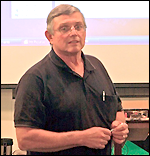
By Rich Hane
My dear Uncle Joe married my Mom’s sister in 1937. He soon went to work for the Santa Fe Railroad at the giant Corwith Yard on the near southwest side of Chicago as a mechanic. Corwith was built in 1887 by the Santa Fe and at the time was the largest railroad yard in the world. He always said that it was a good company to work for and the economic Depression was just starting to loosen its grip on the nation.
He was what I would call a general mechanic doing whatever was needed and worked on all manner of engines, freight cars, and passenger cars. He disliked working on the large numbers of stock cars which came in to deliver animals to the nearby Chicago stockyards. Things got real busy starting a year or two before World War II as the country started the huge buildup needed to arm the military and the civilian economies. He was a bit too old to go into the service and his railroad job might have exempted him. One of the interesting things that he did during the war was to ride on some of the passenger trains as an emergency mechanic to repair the train on its way to Fort Madison, Iowa. The trains were on a tight schedule and it was important to minimize any problems that might delay or tie up the main line west. Fort Madison was a division point on the Santa Fe just west of the Mississippi River about 240 miles from Chicago. The trains carried a supply of spare parts and tools in the baggage car that the mechanic could use to hopefully keep the train running. He would spend the night in Fort Madison and then do the same job on the return trip to Chicago.
Uncle Joe said that the number of trains coming and going was just unbelievable and everyone was so busy. He occasionally had to sleep overnight at the yard when things were really busy. One interesting side story was that whenever the mechanics and laborers had some free time they would assemble freight car kits that came in to the yard from some other company. These were shipped with all of the parts needed to construct a finished freight car.
When the war was finally over he worked about another year before he was laid off to make room for the GIs who were former employees that were returning home and that the Santa Fe had promised to rehire when they came home after saving the world (my well founded opinion).
Uncle Joe then became a chicken farmer for 3 years before almost going broke and followed this with jobs at General Electric and Sylvania. Later, I will write about him and me and some model trains.
Work continues on NC&StL 576 at the Nashville & Western facility in Nashville, Tennessee. Following the 576 in the January PennyRail, I wanted to include some photos of the beginning stages of restoration as seen below. You can see printed details of the work on the Steam Nashville Facebook page. Simply search “Steam Nashville” in your Facebook search window. – Bill Thomas
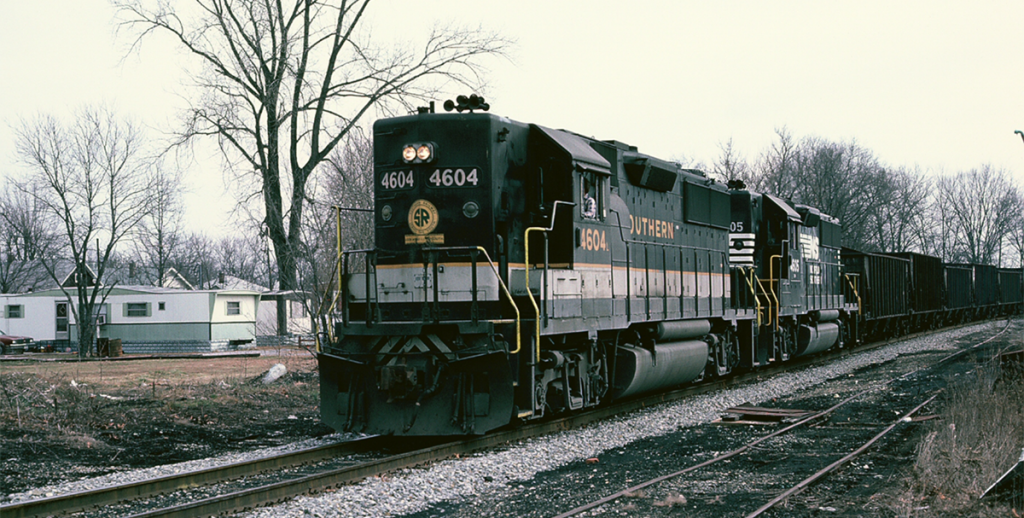
– photographer unknown, from the collection of Chris Dees
A lot of railfans don’t realize that the Southern Railway, and its successor Norfolk Southern, once operated over 100 miles of track in the far southern Illinois region known as “Little Egypt”. Originally a part of the Big Four and NYC, the Cairo Branch from Mount Carmel to Cairo was operated by Conrail until its 1982 sale to Southern Railway. The prospect of future coal mining was the major impetus for the purchase and rebuilding of the line, but after just six short years, NS abandoned the route in 1988. Seen here at Harrisburg during those tumultuous six years are two rare birds on a Harrisburg-Karnak coal train, EMD GP49s 4604 and 4605. Originally built as an order of six GP39X locomotives in November 1980, the units were upgraded to GP49 specifications shortly after purchase. Today they serve on Tri-Rail commuter trains in Florida. The railroad now serves as the Tunnel Hill State Trail system.
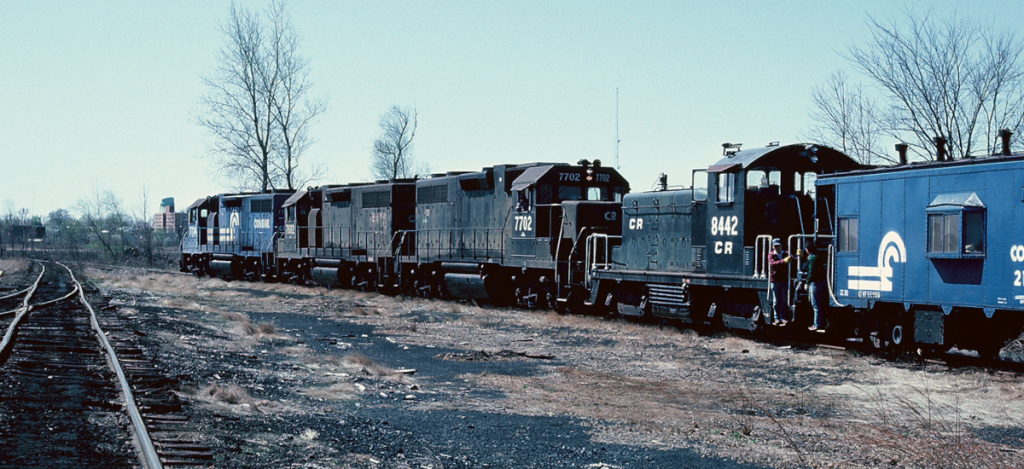
– photographer unknown, from the collection of Chris Dees
March of 1982 brought word to Conrail employees in Harrisburg, Illinois that the line sale to Southern Railway had finally been completed. In what some would see as a parallel to the book of Exodus, the line had experienced its share of oppression and plague: washed out tracks south of Olmsted since 1973, multiple 5 mph slow orders on weed covered tracks, deferred maintenance, Clean Air Act legislation, and the overall decline of coal mining in the area. With possessions packed, the final Conrail train to depart Harrisburg, Illinois begins the trek north to Mount Carmel. Southern will begin operations the following day.
Photos by Bill Farrell and & Blair Terry
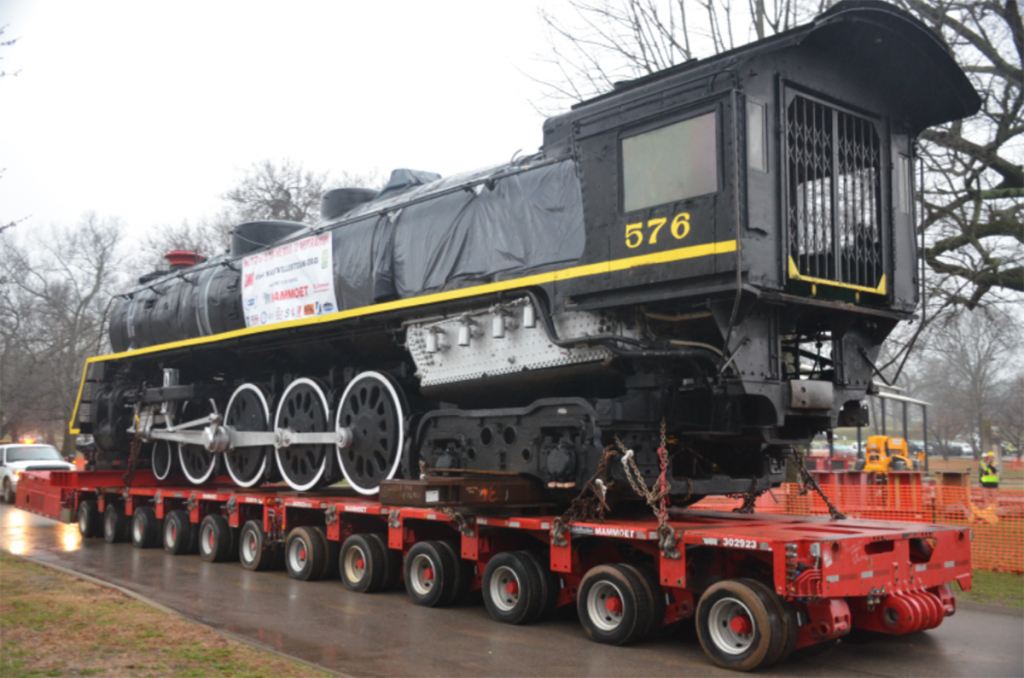
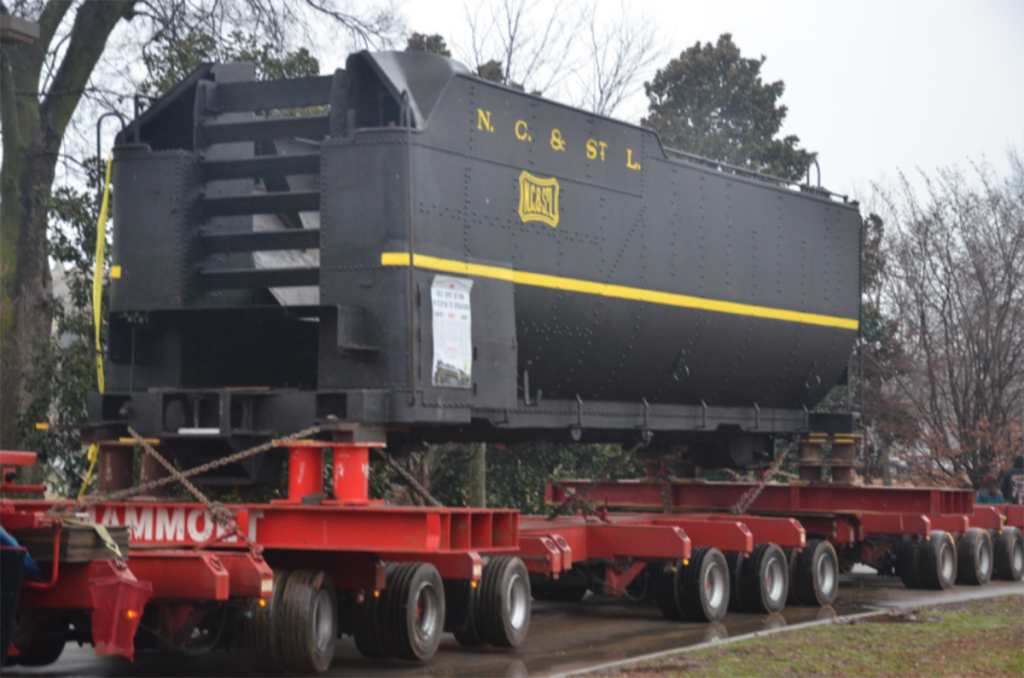
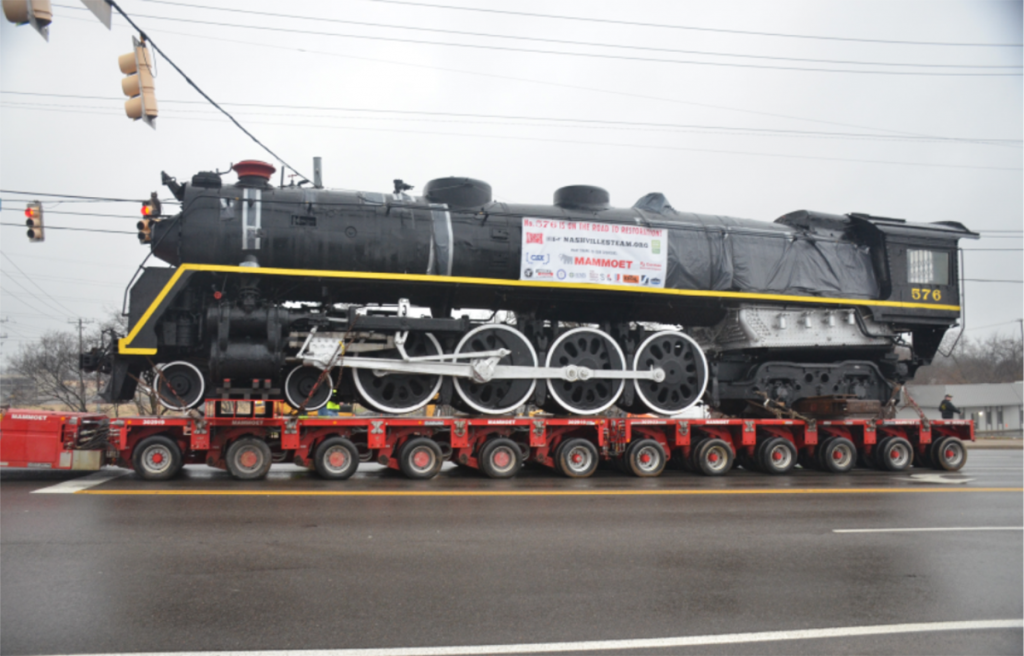
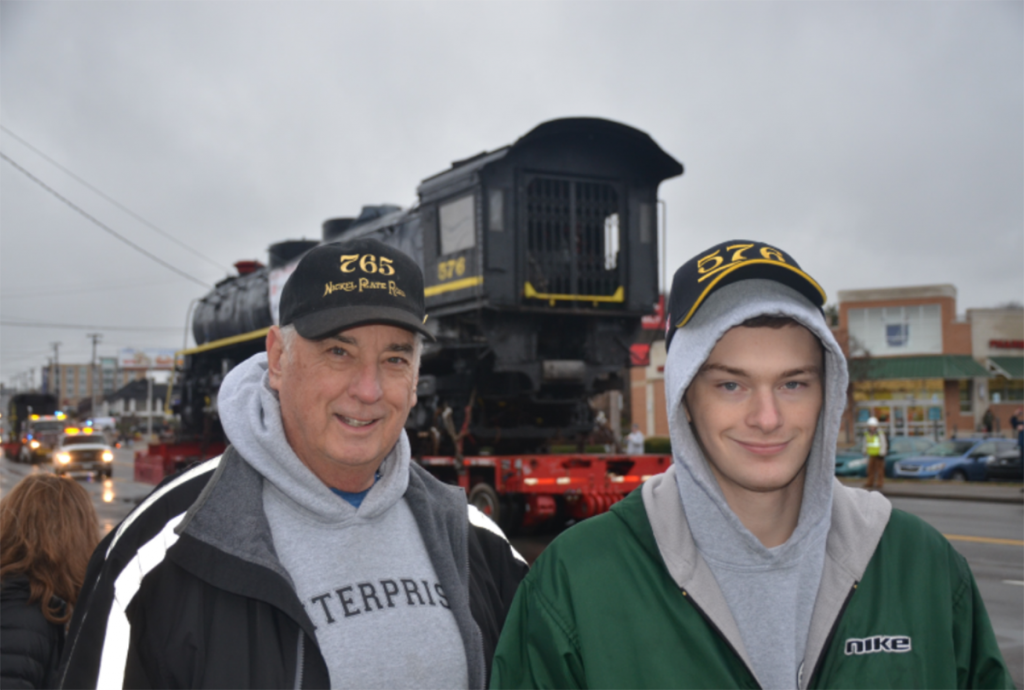
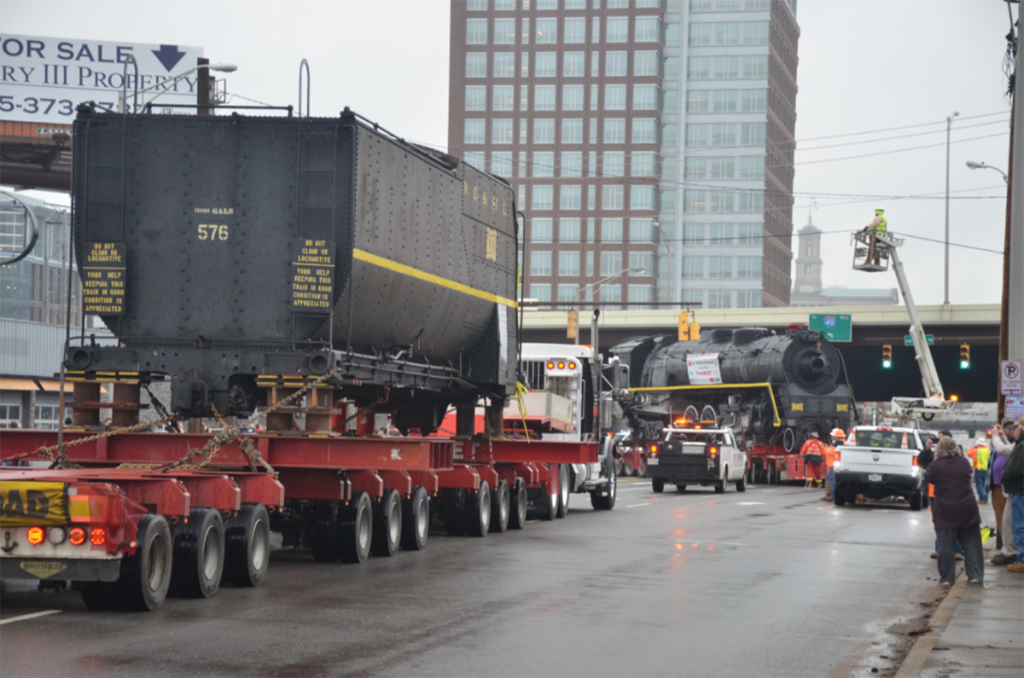
The Northern type locomotive (4-8-4) was moved from Centennial Park in Nashville to the Nashville & Western Railroad Tracks about a mile northeast of the park. The locomotive and tender were loaded up Friday on flat beds for the move early Sunday morning. Picture 1 is of the 576 leaving Centennial Park, the flat bed is self-propelled. Photo 2 is of her tender minus it’s trucks. The trucks were taken on to the Nashville & Western RR earlier. Photo 3 was shot on Charlotte Pike, as the locomotive moved slowly toward it’s unloading point. Photo 4 is of Bill Farrell & Blair Terry as they followed the 576 down Charlotte Pike. Finally, photo 5 is a shot of both the locomotive and tender as they make a left turn off Charlotte on to 12th Ave. North.
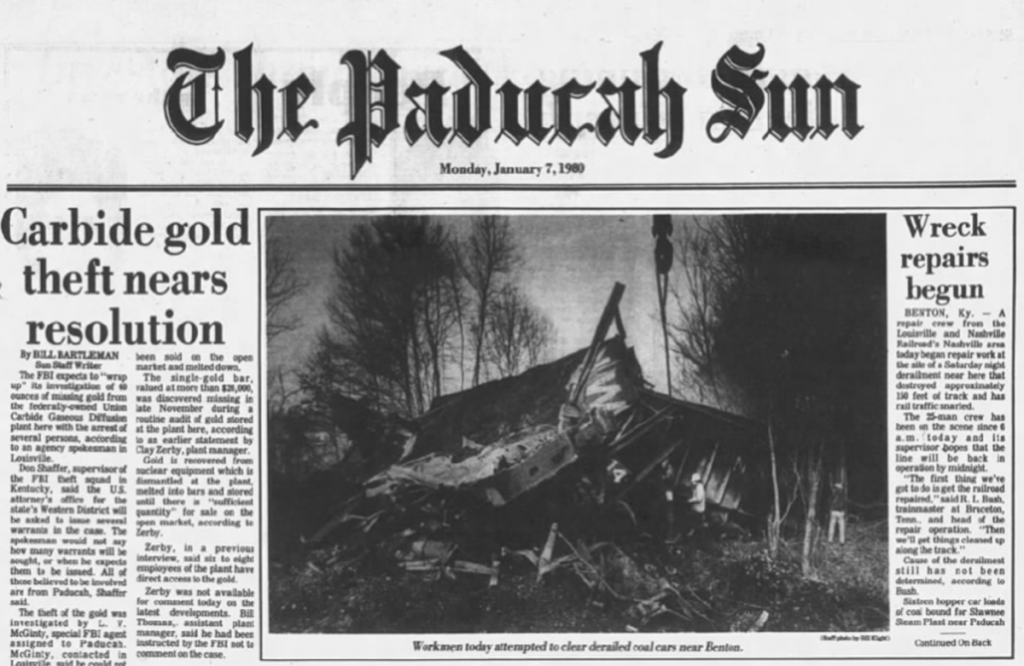
By Chris Dees, Chapter Member
Many of you in the Madisonville area might recall the Western Kentucky Railway, created in 1995 to take over operation of the remnants of the former Tradewater Railway. With reporting marks of WKRL, the Western Kentucky Railway owned lines from Providence to a junction at Blackford, from Blackford north to Waverly, and the line from Blackford south to Princeton. Most of the north-south line, once the main line of the Ohio Valley Railway (an Illinois Central Railroad predecessor) was abandoned in 1995 and 1996, leaving only the piece between Blackford and Dekoven . The Fredonia Valley Railroad later acquired the section from Princeton to Fredonia and it is still in operation today. The rest of the line was abandoned in 2010 and removed from Providence to Wheatcroft and the surrounding mines.
However, there was an earlier rail company by the name of Western Kentucky Railroad Company, and the way I found out about it has a lot of the similar excitement and drama of History Channel’s Curse of Oak Island television series.
I grew up in Marshall County, Kentucky, and although today’s railfans would easily recognize the Paducah & Louisville (formerly Illinois Central Kentucky Division) mainline in the northern part of the county, most are unaware of a small branch line of the Louisville & Nashville that crossed the county on a diagonal from Paducah, through the county seat of Benton, to Hardin and down to Murray. Originally the mainline of the Paducah, Tennessee & Alabama Railroad, the railroad line was transferred a couple of times before becoming the Paducah Branch of the L&N.
The 38-mile line north of Hardin to Paducah was abandoned by L&N in 1982, and a research project this past fall of 2018 resulted in a huge amount of railroad history I was never aware of, including one event that just left me scratching my head with the words “Really ???” echoing back through 35+ years.
I started with some internet searches, and soon found that the Marshall County Library had scanned the complete collections of all county newspapers since the 1880s available on-line to card-carrying members. A quick call to the main branch explaining my Marshall County roots and interest in railroad history got me the necessary credentials and access to a wealth of information. If you haven’t tried this type of research, it can be amazing and provide you with many new adventures as a member of the NRHS.
Like many abandonments of the early 1980s, local businesses and government officials fought the abandonment quite heavily, including the formation of the Purchase Area Rail Support Association, or PARSA. Consolidated Aluminum, Marshall County Soil Improvement Association, Kashway Building Materials, Treas Lumber Company, and Hardin Grain Elevator worked with L&N, fought with L&N, and tried numerous ways to preserve rail service to Benton and Hardin. On April 1, 1981, several L&N employees and railroad investors formed the Western Kentucky Railroad Company, headquartered in Paducah, in an attempt to purchase the track and form a short line railroad company. Although the attempt was unsuccessful due to not being able to agree on a reasonable price, the efforts of PARSA and WKRC did extend the life of the L&N in Marshall County, and eventually resulted in Jack Dunigan, owner of the Hardin Grain Elevator, purchasing a shorter segment from Hardin to Murray that became the J&J Railroad. In the early 1990s, the J&J Railroad was sold to Hardin Southern, who provided tourist railroad service on the line before it was abandoned in the early 2000’s.
One search revealed probably the most interesting newspaper article I have found to date regarding this railroad line, the January 1980 derailment of a 77-car coal train at Benton, Kentucky. That’s right, 77-cars of coal going up the old Paducah Branch to its final destination of TVA’s Shawnee Steam Plant. Since the L&N had part ownership of the Paducah & Illinois Railroad, it could directly service TVA. But what’s more interesting is the fact that by this time, the L&N “Memphis Line” between Guthrie, Clarksville, and Paris would have been severed at the Tennessee River bridge in Danville, Tennessee. The routing would have been via Nashville, New Johnsonville, and Bruceton. And a search of The Paducah Sun shows a clear photo not of L&N hoppers, but Norfolk & Western coal hoppers at the derailment site. Whether this was an interchanged train from N&W, an L&N detour from a more direct route via Madisonville and the ICG Kentucky Division, or what, I have yet to find out. Certainly a good mystery.

By Ricky Bivins, Chapter President
Greetings fellow NRHS Western Kentucky Chapter members. And welcome to January, 2019. My oh my what are year 2018 was. Looking back we had the Christmas show at the mall, breakfast with Santa, an excellent Christmas dinner at the Miller residence, a picnic and rail fan day at Crofton, a railfan day in Hopkinsville, a meeting in Hopkinsville, a track side day in Morton’s Gap not to mention numerous meetings, impromptu get-togethers and programs a plenty. I feel 2019 will be even better.
As you are aware, we did not have a business meeting in December however, we did have the aforementioned dinner at the Miller residence, a very successful breakfast with Santa and a successful Christmas show at the mall. Bill Farrell will have a report on the earnings from those events. Not to mention the raffle which netted us additional monies as the winner did not take the train set.
We did however have a meeting in November. Which also brought about elections of officers for 2019. There were no changes in officers as all were voted in by a single vote of acclamation. To which I say thank you. Hopefully I can serve as President as need be.
2018 also brought on a few new members. It is nice to think that we can continue to grow in this age of electronics and instant gratification. As for growing in 2019, I have always said, if a member has an idea bring it forward. We will entertain all thoughts of growth and events as well. If there is something you would like for the Chapter to do, sponsor it. And it will be done!
As is customary in January, the president which is I, will have the program and refreshments. My program will be a 1984 VHS video of Chesapeake and Ohio 4-8-4 number is 614 pulling coal trains in the mountains of Virginia and West Virginia. Along with the video we will have a guest speaker. If you recall a few years ago my oldest stepson Brian Davis who works for CSX as a conductor gave us a talk. Brian is on call meeting night and if he is not on the railroad he will be at the meeting to give us a follow-up to that program. That is tentative provided he is available at the time.
They extended forecast for meeting night is clear and cold. Keep in mind should we have inclement weather I will cancel the meeting. No need for anyone to get out slip and fall or worse. Otherwise I hope to see you Monday, January 21, 2019. Bring a friend as all are welcome.